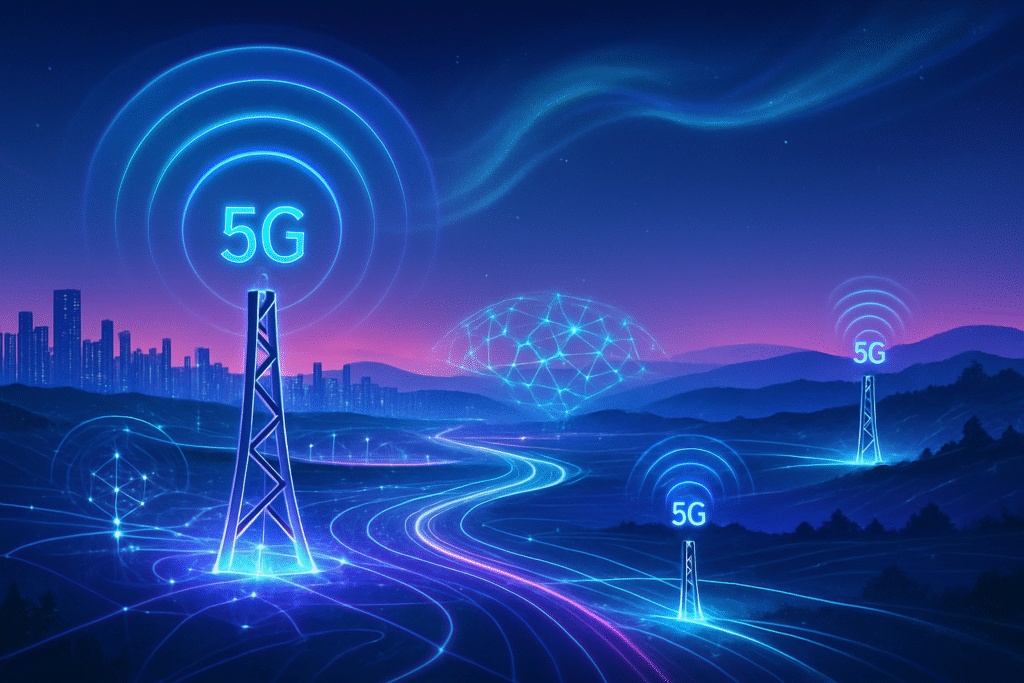
A new report from J.D. Power, released on October 9, 2025, has sent ripples through the telecommunications industry, revealing a dramatic surge in residential wireless internet sign-ups and crowning T-Mobile (NASDAQ: TMUS) as the national leader in customer satisfaction. The "2025 U.S. Residential Internet Service Provider Satisfaction Study" highlights a significant shift in consumer preference, with wireless internet providers experiencing a 15% increase in new subscriptions over the past six months—more than double the growth seen by traditional wired providers. This pivotal moment underscores the growing appeal of Fixed Wireless Access (FWA) as a viable and often superior alternative to conventional broadband.
The findings from J.D. Power's comprehensive study, which surveyed nearly 28,000 internet service customers between August 2024 and August 2025, paint a clear picture: wireless internet is not just a niche offering but a rapidly expanding segment of the market. T-Mobile's impressive score of 663 on a 1,000-point scale, significantly above the wireless segment average of 647, marks its second consecutive year at the top. This consistent leadership points to a successful strategy in delivering high-quality, affordable, and user-friendly internet solutions, fundamentally altering the competitive dynamics of the broadband sector.
The Technical Edge: How Fixed Wireless Access is Redefining Connectivity
The surge in wireless internet adoption is primarily driven by advancements in Fixed Wireless Access (FWA) technology, which leverages existing 5G and, to a lesser extent, 4G LTE cellular networks to deliver broadband directly to homes and businesses. Unlike traditional wired internet services—such as DSL, cable, or fiber optics, which require physical lines laid to each premise—FWA utilizes a wireless modem or gateway that receives signals from nearby cellular towers. This eliminates the need for extensive infrastructure deployment to individual homes, making setup significantly faster and often more affordable.
Technically, FWA's appeal stems from several key capabilities. Modern 5G networks, particularly those utilizing mid-band and millimeter-wave (mmWave) spectrum, offer robust speeds comparable to, and in some cases exceeding, traditional cable broadband. The ease of installation is a major differentiator: customers can often self-install by simply plugging in a device, bypassing the need for technician visits and complex wiring. This "plug-and-play" simplicity, combined with transparent pricing models and flexible plans, stands in stark contrast to the often cumbersome installation processes and hidden fees associated with conventional internet service providers. The J.D. Power report specifically cited internet speed, availability, ease of starting service, and lower price points as key drivers of satisfaction for wireless internet customers.
This approach fundamentally differs from previous wireless internet attempts, which often relied on slower 4G LTE networks or satellite connections that struggled with latency and data caps. The maturation of 5G, with its enhanced bandwidth and lower latency, has transformed FWA into a truly competitive broadband solution. Initial reactions from the AI research community and industry experts suggest that FWA's growing footprint provides a critical foundation for broader AI adoption, particularly in areas where high-speed wired internet is scarce. The proliferation of accessible, high-speed wireless internet can accelerate the deployment of edge AI applications, smart home technologies, and remote work solutions, democratizing access to the digital tools essential for AI-driven innovation.
Competitive Ripples: Shifting Dynamics for Tech Giants and Startups
The rapid ascent of Fixed Wireless Access and T-Mobile's leadership position are sending significant competitive ripples through the telecommunications and broader tech industries. T-Mobile (NASDAQ: TMUS) stands to benefit immensely from this development, solidifying its position not just as a mobile carrier but as a formidable broadband provider. Its strategy of leveraging its extensive 5G network for home internet has clearly resonated with consumers, giving it a strong strategic advantage in capturing market share from traditional internet service providers (ISPs).
Competitors like Verizon (NYSE: VZ), which also offers 5G Home Internet, and AT&T (NYSE: T), which is expanding its own FWA offerings, are under pressure to accelerate their deployments and enhance their customer experience to match T-Mobile's performance. The J.D. Power report serves as a benchmark, highlighting areas where these tech giants need to improve to compete effectively in the burgeoning FWA market. For traditional wired ISPs such as Comcast (NASDAQ: CMCSA) and Charter Communications (NASDAQ: CHTR), the rise of FWA represents a significant disruption. They face the challenge of retaining customers who are increasingly drawn to the flexibility, ease of use, and competitive pricing of wireless alternatives. This could lead to increased price competition and a renewed focus on improving customer service and upgrading infrastructure (e.g., fiber expansion) to differentiate their offerings.
Furthermore, this trend opens doors for innovative startups in areas like network optimization, customer premise equipment (CPE) development for FWA, and AI-driven service management. Companies specializing in efficient spectrum utilization, dynamic network slicing for FWA, or AI-powered predictive maintenance for wireless networks could find fertile ground. The market positioning of FWA providers is increasingly strong, as they offer a compelling alternative to incumbent wired services, especially in underserved rural areas and competitive urban markets where consumers seek more choices and better value. This shift is compelling major AI labs and tech companies to consider how ubiquitous wireless broadband impacts their cloud service delivery, edge computing strategies, and the deployment of AI-powered applications that rely on reliable home connectivity.
Broader Significance: Reshaping the AI Landscape and Digital Equity
The soaring adoption of wireless internet, spearheaded by FWA, signifies a profound shift in the broader AI landscape and global connectivity trends. This development directly contributes to closing the digital divide, offering high-speed internet access to millions of households, particularly in rural and underserved areas where laying fiber optic cables is economically unfeasible. By providing a more accessible and affordable pathway to broadband, FWA acts as a critical enabler for AI adoption across wider demographics, allowing more individuals and small businesses to leverage cloud-based AI services, participate in online learning, and access AI-powered productivity tools.
The impacts extend to the very infrastructure supporting AI. As more data is generated and consumed at the edge of the network via FWA connections, there's a growing need for distributed AI processing capabilities. This trend accelerates the development of edge AI technologies, pushing computational power closer to the data source and reducing reliance on centralized cloud data centers for every operation. Potential concerns, however, include the strain on existing wireless spectrum and network capacity. While 5G offers significant bandwidth, a massive increase in FWA subscribers could lead to congestion in certain areas, potentially impacting service quality for both mobile and fixed wireless users. Regulatory bodies will need to carefully consider spectrum allocation and network infrastructure investments to sustain this growth.
Compared to previous AI milestones, such as the rise of cloud computing or the breakthrough in deep learning, the widespread adoption of FWA represents a foundational shift in access. It democratizes the ability to participate in the AI-driven economy, moving beyond geographical and economic barriers that previously limited broadband availability. This widespread connectivity is essential for the next wave of AI applications, from smart cities and autonomous systems to advanced telemedicine and remote education, all of which rely on robust, pervasive internet access.
The Horizon Ahead: Future Developments and AI Integration
Looking ahead, the trajectory of wireless internet, particularly FWA, is poised for significant evolution, with profound implications for AI. In the near term, we can expect continued expansion of 5G FWA coverage as carriers densify their networks and optimize their spectrum utilization. This will likely lead to even faster speeds and greater reliability, making FWA an even more compelling alternative to traditional broadband. We'll also see further innovation in customer premise equipment (CPE), with more sophisticated AI-powered routers that can intelligently manage network traffic, optimize Wi-Fi performance, and integrate seamlessly with smart home ecosystems.
Longer term, the advent of 6G technology promises to unlock unprecedented capabilities for wireless internet. While still in its nascent stages of research and development, 6G is envisioned to deliver terabit-per-second speeds, ultra-low latency, and pervasive connectivity, creating a truly intelligent and connected environment. These advancements will enable a new generation of AI applications, including holographic communication, real-time AI-powered digital twins, and highly distributed AI systems operating across vast sensor networks. Potential applications on the horizon include enhanced augmented and virtual reality experiences powered by edge AI, intelligent transportation systems relying on real-time FWA data, and advanced remote healthcare solutions.
However, challenges remain. Addressing potential network congestion, ensuring equitable access to advanced spectrum, and developing robust cybersecurity measures for a vastly expanded wireless internet footprint are critical. Experts predict that the next phase will involve tighter integration of AI directly into network management and optimization, using machine learning to predict traffic patterns, allocate resources dynamically, and proactively identify and resolve issues. This intelligent network infrastructure will be essential to support the ever-increasing demands of AI-driven services.
A New Era of Connectivity: Wrapping Up the Wireless Revolution
J.D. Power's latest report unequivocally signals a new era in home internet connectivity, with wireless internet, particularly Fixed Wireless Access, emerging as a dominant force. The key takeaway is the dramatic shift in consumer preference towards FWA, driven by its ease of use, competitive pricing, and increasingly robust performance. T-Mobile's consistent top ranking underscores the importance of customer satisfaction and effective network deployment in this rapidly evolving market. This development is not merely a change in internet service providers; it represents a fundamental recalibration of the broadband landscape, with significant implications for how individuals and businesses access and leverage digital resources.
The significance of this development in AI history cannot be overstated. Widespread, affordable, and easy-to-deploy wireless internet is a foundational layer for the ubiquitous adoption of AI. It accelerates the growth of edge computing, democratizes access to AI tools, and creates the necessary infrastructure for future AI innovations that rely on pervasive, high-speed connectivity. The long-term impact will likely see FWA becoming a primary broadband option for millions, fostering greater competition, and driving further technological advancements in both wireless communication and AI.
In the coming weeks and months, watch for other carriers to intensify their FWA offerings, increased investment in 5G network expansion, and potential regulatory discussions around spectrum allocation to support this growing demand. This wireless revolution is far from over; it's just beginning to show its true potential in shaping a more connected and AI-powered future.
This content is intended for informational purposes only and represents analysis of current AI developments.
TokenRing AI delivers enterprise-grade solutions for multi-agent AI workflow orchestration, AI-powered development tools, and seamless remote collaboration platforms.
For more information, visit https://www.tokenring.ai/.





